Author: Honeywell Sensing and Control Chris Gottlieb
Hall effect rotary position sensors for measurement, monitoring and data feedback are an integral part of many transportation and industrial applications.
In most private or heavy-duty motor vehicles, there are a wide variety of spare parts, switches and sensors, one of which is a noteworthy component – ​​the Hall effect rotary position sensor, which may be used in In applications such as cars, trucks, buses and ships.
The Hall effect rotational position sensor is intended to measure the angular position of a moving element by a magnetic field rather than a mechanical brush or mechanical gear. This type of sensor uses a Hall-effect integrated circuit (IC) with magnetic bias to sense the rotational movement of the actuator shaft while performing a series of operations. Rotation of the actuator shaft changes the position of the integrated circuit relative to the magnet, thereby varying the flux density, converting the output of the integrated circuit to a linear output within a 90° stroke, providing feedback to the driver or vehicle subsystem.
Solid state Hall effect technology provides non-contact operation. The magnetic field is used inside the sensor, not the arc brush used in the potentiometer. The arc brush of the potentiometer causes friction and reduces product life. The non-contact magnetic field Hall effect technology using the rotary position sensor not only reduces mechanical losses, but also reduces the execution torque, thus extending the service life of the product.
Hall effect rotary position sensors are cost effective and are used in harsh environments for transportation and industrial applications.
Potential transportation applications
Foot pedal position sensing
In heavy-duty equipment and other vehicles, the Hall-effect rotary position sensor can replace the mechanical cable connection between the foot pedal and the engine. Mechanical cables can be pulled or corroded and require periodic maintenance and recalibration. Replacing mechanical cables improves engine control system response and vehicle emissions, increases reliability and reduces overweight. This electronic throttle system is safer and more economical than a cable connection system.
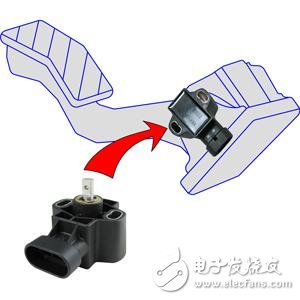
Honeywell RTY Series Rotary Position Sensors for Foot Pedal Position Sensing
For example, the rotational position sensor can be mounted adjacent to the foot pedal to measure the distance the foot pedal is depressed. The more powerful the driver steps, the lower the pedal pressure is, the more fuel and air will flow to the engine, and the faster the vehicle will drive. When the driver's foot releases the pedal, the Hall effect rotary position sensor senses a change in pedal position, signaling the engine to reduce fuel and air through the throttle. The vehicle will slow down in response to this signal.
Bus and truck suspension / automatic door pedal induction
The Hall effect rotary position sensor can also be used in bus and heavy truck lift height systems to sense the travel of the suspension system. The bus uses an automatic pedal to lower its height from the ground, making it easier for passengers to get on and off the bus. Hall effect rotary position sensors can be used at both ends of the application: one sensor monitors the position of the control rod and the second sensor is deployed on the suspension arm or connecting rod to monitor the ground clearance.

Precise position sensing confirms that the vehicle is at the correct height for the application's requirements, improving the convenience of the vehicle's access. Large trailers can also use the Hall effect rotary position sensor to monitor the trailer height and increase the efficiency of warehouse docking.
Seven important questions: What specifications should a design engineer consider when selecting a Hall effect rotary position sensor?
1. Durability. Engineers should consider what type of environment the equipment will work in. For challenging environments, the enclosure should be rated for IP67 for higher product durability. This is especially important for vehicles and equipment that typically operate in harsh climates and environments.
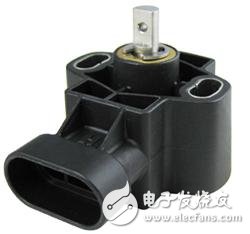
Honeywell's RTY Series Hall-Effect Rotary Position Sensors, with its bearing design and associated IC circuit quality, have a product design life of 15 million rotations
2. Service life. The official life of the device is clearly indicated on the product data sheet. The number of rotations is best performed by the sensor manufacturer, so your engineering staff can save time.
3. Specify the integrated connector. The sensor's integrated connector has two important advantages, one is smaller size and the other is longer life. Sensors with integrated components are smaller than the overall package size of the sensors that rely on pigtails, allowing developers to design and build smaller overall systems. The use of an integrated connector eliminates the well-known and easily damaged pigtails and significantly increases durability because the wires in the pigtail are subject to stress damage, wear and biting or folding by rodents.
4. EMI/EMC immunity. Radio waves of different frequencies can cause interference to electronic equipment. Automotive-grade EMI/EMC protection against wireless RF in the environment provides guaranteed sensor performance.
5. Standardized I/O. Save time, effort, and money with industry-standard AMP terminals, 32 mm mounting pitch, and universal pin layout types. Standard I/O greatly simplifies plug-in replacement because its mounting points, heights, and feet are basically the same as existing equipment.
6. Sensor flexibility. Before choosing a sensor, you should first determine whether you are using only one type of power supply or you need to use multiple input voltages. Use a position sensor with multiple operating voltages or operating voltage ranges for your convenience. A wide range of operating voltages allows design engineers the flexibility to design solutions that meet the different travel needs of many common applications.
7. Is the sensor supplier reliable? It is important to consider whether the supplier can provide the design, testing, product quality and customization techniques required for the product. In addition, if suppliers are familiar with and understand international standards, as well as production / delivery processes and policies, it is even more icing on the cake.
Hall effect position sensors are designed to measure, monitor and provide feedback and are an integral part of many transportation and industrial applications. Choosing the right sensor and supplier for your design application is the foundation for your project's success.
In addition to transportation applications, Hall effect rotary position sensors are also widely used in industrial applications.
Irrigation hub control
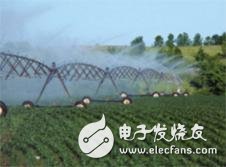
One of the most popular uses for Hall effect rotary position sensors is the sprinkler system used on large farms. The sensor monitors the angular extent of the nozzle when it is being irrigated. Whether the irrigation system sprays water onto the land you wish to water, or the system can reach 360 degrees. These technical knowledge can help agricultural workers reduce water consumption and increase farmland output.
Valve position sensing
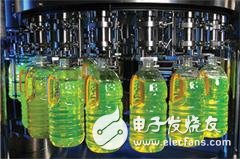
One common industrial application is the control of process valves. Oilfields, nuclear power plants, food processing plants, and beverage manufacturers all need to monitor valve positions. Hall effect rotary position sensors are used to monitor the position of large and small valves, helping to ensure that the valve is closed or to monitor how the valve opens.
HVAC baffle control
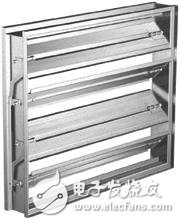
Heating, ventilation and air conditioning systems use a rotary position sensor to control the baffle. On cold days, the open baffle will allow cold air to enter the room and the HVAC system will begin to heat up. For rooms with windows open, the open baffle also allows outdoor air to enter, reducing system performance and increasing heating and cooling costs. Efficient use of Hall-effect rotary position sensors and temperature sensors can help property managers better manage HVAC systems and reduce operating expenses.
Jewelry Lights,High Power Jewelry Lights,60W New Jewelry Lamp,COB Jewelry Lamp
SHENZHEN KEHEI LIGHTING TECHNOLOGY CO.LTD , https://www.keheiled.com